Forest Research: Open Access
Open Access
ISSN: 2168-9776
+44 1300 500008
ISSN: 2168-9776
+44 1300 500008
Research Article - (2021)Volume 10, Issue 3
Invasive Alien Plant Species (IAPS) are major threat to the earth’s plant biodiversity. With the rapid expansion of IAPS in Nepal, the techniques of using IAPS in form of charcoal have derived profound benefit to the forest condition. This study aims to analyse the effect of removal of IAPS on forest management in terms of plant diversity at regeneration level. In addition, the impact on the species richness, species evenness and stand density was also studied for three community forests representing different physiographic zones of Nepal. Each forest was divided into two blocks- treatment applied block and control block with size of 20 ha each. Treatment block represented the IAPS removed forest area while control block represented forest area with no intervention. The study was conducted using stratified random sampling. Forest inventory with nested circular plot of 500 m2, was performed in both blocks to figure out the changes in regeneration level. Shannon-Wiener diversity index was used to assess the change in diversities at regeneration level. Margalef index and Pielou’s evenness index were used to calculate species richness and evenness. According to Shannon-Weiner index, treatment block showed significantly higher plant diversity and a greater number of seedlings and saplings in comparison to control block. Similarly, the value of Margalef index and Pielou’s evenness index were greater in treatment applied block. Species density at regeneration level and growing stocks of trees were found higher in treatment applied block while species density at tree level in the control block. It is suggested that promotion of invasive species management through policy level/main actors of forest sector, capacity enhancement of local forest user and proper financing could be a strategy to secure dual benefit to forest and its user.
Invasive alien species; Diversity; Treatment; Control
Invasive alien plant species in Nepal
Invasive Alien Plant Species (IAPS) are species, native to one area or region, that have been introduced into an area outside their normal distribution, either by accident or on purpose, and which have colonized or invaded their new home, threatening biological diversity, ecosystems and habitats, and human wellbeing [1]. Such species impose a major threat to the earth’s biodiversity through their effect on the structure and functioning of ecosystems [2]. Invasive species will threaten human livelihoods hugely in low- HDI countries and in the biodiversity strongholds, where they are less recognized [3,4]. Current policies in many countries are not equipped to address the threats of invasive species mainly in Africa and Asia. Similarly, global biodiversity hotspot in Central America, Africa, central Asia, and Indochina are vulnerable to invasion due to their little capacity to respond [5]. Biological invasion has been considered as an important component of global environmental change and a leading cause of decline and/or loss of native biodiversity and ecosystem services [6-9]. Bio-invasion may be considered as a significant component on global change and of the major causes of species extinction [10]. The climatic condition and geographical variations make Nepal a hotspot for wide range of flora and fauna. Nepal lies at the crossroad of six floristic provinces of Asia (Sino-Japanese, South eastern Asiatic, Indian, Sudano- Zambian, Irano-Turranean and Central Asiatic and the floral elements of all provinces are represented in Nepal [11,12]. Due to the widest elevation gradient and heterogeneous geomorphology, organisms from anywhere of the world may find suitable habitat and climatic condition in Nepal. The majority of alien plant species in Nepal are confined to the low lands below 2,000 m, whereas the highest concentration of endemic species (up to 91%) occurs in a sub-alpine zone (3,000-4,000 m), particularly in central Nepal [12]. Among 6419 flowering plant species in Nepal, there are at least 219 alien species of flowering plant [12-14]. Government of Nepal has identified 21 remarkable IAPS creating various level of risk on biodiversity and ecosystem [15]. These remarkable IAPS were prioritized based on their invasive character and species such as Ageratina adenophora, Chromolaena odorata, Lantana camara, Mikania micrantha, Eichhornia crassipes and Ipomoea carnea are considered to be the alien species of extreme threat to native species and ecosystems. The various ecosystems of Terai, Chure (Siwaliks) and Midhills of Nepal are seriously threatened by IAPS [16]. IAPS disrupt the ecology of a natural ecosystem, displace the native plant and animal species and degrade unique and diverse biological resources of the landscape. The impact of invasive plant species on native species, communities and ecosystems is manifested in various ways. By reducing species richness and abundance of native biota and decreasing the local species diversity, invasive species reduce the distinctiveness of biological communities at various spatial scales [16-19]. Apart from these, invasive species have negative effects on the genetic variation of native populations via hybridization [20]. Invasive plants can modify soil attributes to facilitate further invasion. Invasive modification of soil micro biota can facilitate plant invasion directly or via ‘cross-facilitation’ of other invasive species, and moreover has potential to impede restoration of native communities after removal of an invasive species [21].
IAPS is considered as an overlooked forest resources in Nepal. With several international agreements, Nepal formulated different policies and laws for the management of IAPS. Nepal Biodiversity Strategy 2002, Nepal Biodiversity Strategy and Action Plan (2014- 2020) and National Wetland Policy 2003 (revised 2012) were formulated identifying that IAS is one of the major causes for the loss of species and habitats [16]. These policies express the commitment to the protection and wise use of biological resources and habitats [16]. The documentation of IAS in Nepal started since 1958, however, the extension, distribution, quantity, and the benefit that can be driven from the utilization of IAS, is scarcely known in Nepal [22].
IAPS use in Nepal
After late 1970’s, upon the recognition of failure of centralized forestry, Nepal is implementing community-based model for sustainable use of forest resources [23]. More than 22,000 community forests are managing 2.23 million ha of the forest in Nepal [24]. The community forest has made a huge influence on the restoration of degraded land, increased supply of forest products and improved livelihood [25-28]. More than 100 community forests in 16 districts of Nepal are doing IAPS management by extracting IAPS from forest and converting the biomass into charcoal. For instance, in fiscal year 2016/17, this approach created around 1050 green jobs and income of around 19 million Nepalese rupees in Nepal [22]. Different mechanical as well as chemical techniques are used for the control and removal of IAPS, but they are effective only for short period whereas, biological control is considered to be the long-term approach to slow down invading process [29,30]. Making bio-charcoal from invasive species by pyrolysis process through energy kiln has been established as thriving approach of invasive species management in community forests of Nepal [31]. The brief process of using IAPS by making charcoal through pyrolysis process in Nepal is illustrated in Figure 1. The primary goal of invasive species management efforts is removing invasive species from the area through any means [32-35]. The level of infestation by IAPS depends on canopy cover, maintenance of high tree canopy cover/ or under-storey vegetation of native species through different management activities could be effective approach to minimize the invasion in forest ecosystem [36].
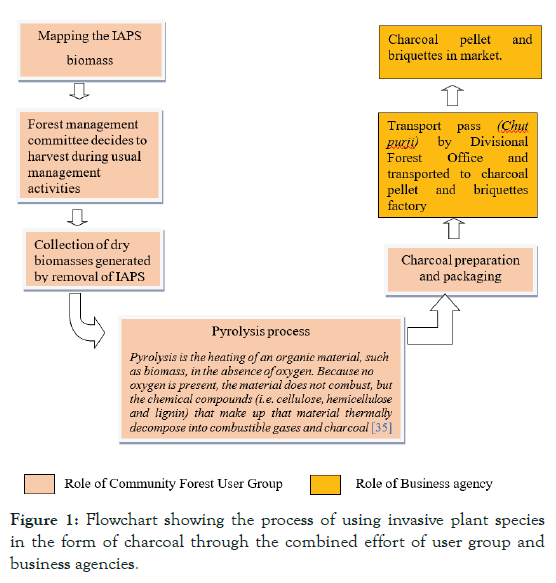
Figure 1. Flowchart showing the process of using invasive plant species in the form of charcoal through the combined effort of user group and business agencies.
The knowledge of the current extent of the IAPS problem and control efforts is relatively poor in much of Africa, and in parts of the Middle East and Asia too [5]. This lack of understanding on IAPS use and its implication on forest management has created difficulty for many community forest user groups to adopt this IAPS management approach in Nepal. The policy of Nepal restricts the transport and use of wood charcoal on one hand and on the other it has overlooked the management of IAPS in compare to other non-timber forest products [22]. This has created hindrance among local people to adopt this approach [22]. IAPS has emerged as both opportunity and a challenge for the sustainable forest management and livelihood upliftment. Various financial and technical assistance is provided by local I/NGOs to involve local community forest users in the invasive species management through charcoal production in Nepal [31].
The first step of this study is to illustrate the impact of removing IAPS on the forest condition. The ecological impact to the forest is studied in terms of species diversity, richness, and evenness. This study also tried to see the impact on regeneration (seedling/sapling) and tree density in three community forest. It aimed to provide the baseline information on the invasive species management which could help to promote this activity as a much-needed treatment for the better forest condition. The next sections of this paper are organized as follows. Section 2 outlines the study area, methods employed in data collection and data analysis. Section 3 present the results of plant diversity, species richness, species evenness and stand density and comparison between two blocks and three forests as well. Section 4 provides the conclusion and some recommendations.
Study area
Community Forest (CF) is an autonomous body [37] that can develop, conserve, use and manage the forest and sell and distribute the forest products independently by fixing their prices according to operational plan [38,39]. As per Community Forest Development Guidelines, every CF must develop own constitution and management plan [40]. The operational plan clearly mentions the forest management activities, prohibited activities inside CF as well as distribution of revenue generated from community forest. The forest management activities like weeding, cleaning, thinning, pruning, and timber harvest are scheduled as per operational plan on a year-basis. Above mentioned activities are carried out by the technical assistance of forest authority, which monitors the community forest in local level [40]. According to guideline, there is also provision of investment of revenue generated by CF, such as at least 35% on pro-poor activities and 25% in forest management [41].
Removal of IAPS is also carried out as the scheduled activities in management plan which anticipate contributing on the forest management and pro-poor activities of the community forest. This study was conducted in three community forests (CF) representing three physiographic zones of Nepal. The detail description of study area is provided in Table 1. These CF were selected because of the efforts of local user for the invasive species management to achieve the mutual benefit for forest and local community. All community forests studied were the natural forest. The operational plan of these included the IAPS removal as their main activity to be implemented in a year-cycle and especially in summer season. Mainly pro- poor families and especially women were involved to collect IAPS and convert them into charcoal.
| CF | Location | Physiographic region |
District | Area (ha) |
Major Tree species | Invasive species used for making charcoal |
|---|---|---|---|---|---|---|
| Thanimai | 84°58'40"E 84°59'42"E (Longitude) 27°11'02"N 27°09'54"N (Latitude) |
Terai | Bara | 199.2 | Shorea robusta, Lagerstroemia perviflora, Adina cardifolia, Dalbergia sissoo | Eupatorium adenophorum, Mikenia micrantha, Eupatorim odoratum, Lanatana camara etc |
| Nawajagriti | 84°26'43"E- 84°28'01"E (Longitude) 27°42'46"N- 27°30'30"N (Latitude) |
Siwalik | Chitwan | 315.7 | Shorea robusta, Adina cardifolia, Dalbergia sissoo, Dalbergia latifolia | Eupatorium adenophorum, Mikenia micrantha, Eupatorim odoratum, Ageratum conyzoides etc. |
| Sagaswoti Laure | 85°47'20"E- 85°48'54"E (Longitude) 27°38'06"N-27°36'54"N (Latitude) | Hill | Kavre | 376.6 | Pinus roxburghii, Schima wallichii, Grevillea robusta, Castanopsis indica | Ageratum conyzoides, Eupatorium adenophorum etc. |
Table 1: Description of study area with invasive species for charcoal production.
Data collection
Each forest was divided into two blocks: treatment block and control block, with size of 20 ha each (Figure 2). Treatment block represented the forest area where IAPS were removed while control block represented normal part of forest without any intervention. The difference in these two conditions illustrates the impact of IAPS on the forest.
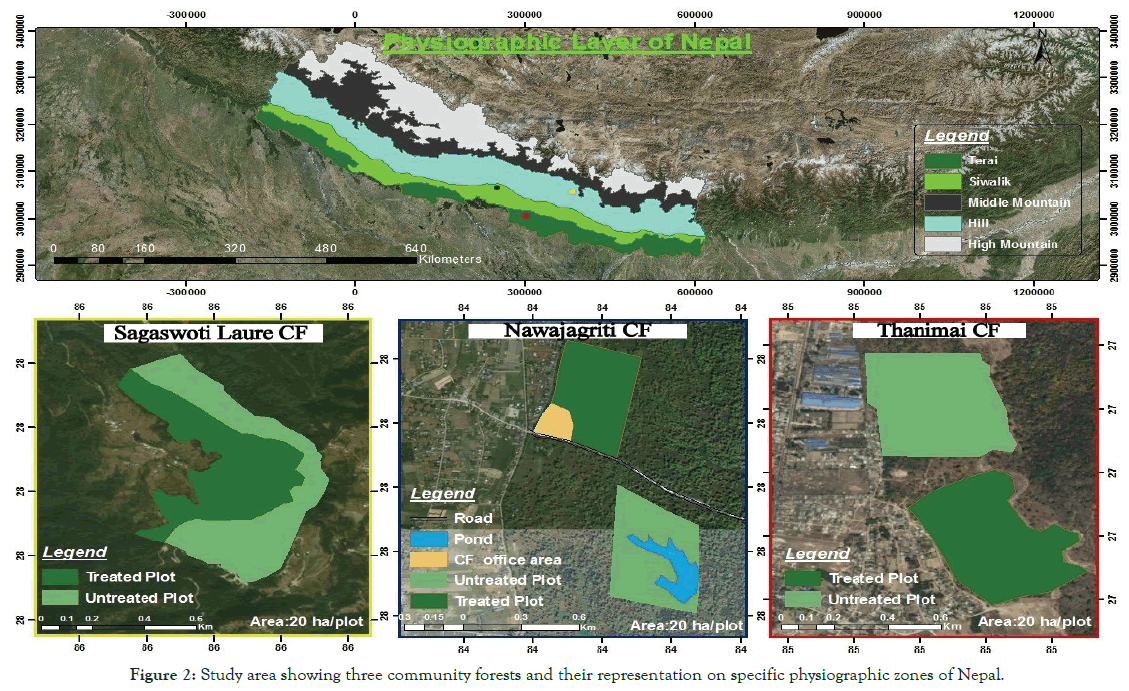
Figure 2. Study area showing three community forests and their representation on specific physiographic zones of Nepal.
Two indicators along with verifiers based on ITTO framework were used to assess ecological sustainability of the community forests. Table 2 presents the indicators used for this study and their reference to ITTO indicators. The detail description of each indicator is presented below while the methods for measuring and calculating are discussed in Data analysis section (Figure 3).
| Indicators | Verifiers | Reference to ITTO indicators |
|---|---|---|
| Forest condition | 1. Regeneration condition 2. Standing growing stock volume |
Indicator 4.2 current level of sustainable harvest for wood and non-wood forest products. |
| Maintenance of tree species diversity | 1. Species composition 2. Species richness 3. Species evenness |
Indicator 5.2 number of rare, endangered, threatened forests depends on species. |
| Source: Adapted from ITTO 2005 [41]. | ||
Table 2: Indicators and verifiers.
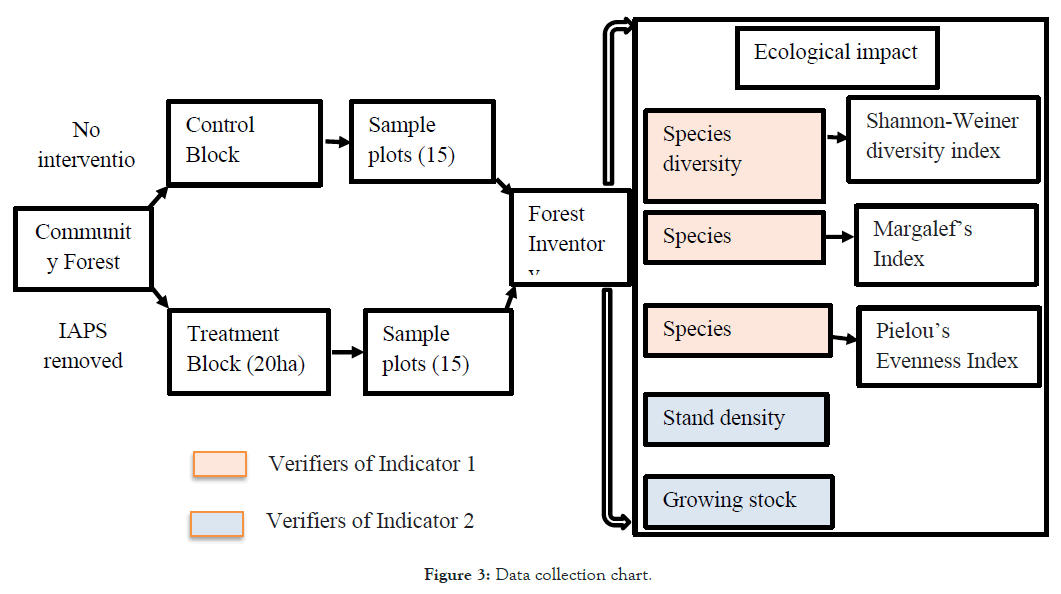
Figure 3. Data collection chart.
Forest inventory
15 nested circular sample plots were established in each of the control and treatment block. The sample plots were laid based on the National Forest Inventory Guideline, Nepal, in 2000 [42] (Figure 4 and Table 3). For each species, the diameter at breast height (DBH) and height were measured for tree, pole, and sapling whereas for the seedlings, the numbers of regenerations were recorded. Additional information was derived from secondary sources including the operational plan of community forests, inventory guidelines and similar literatures.
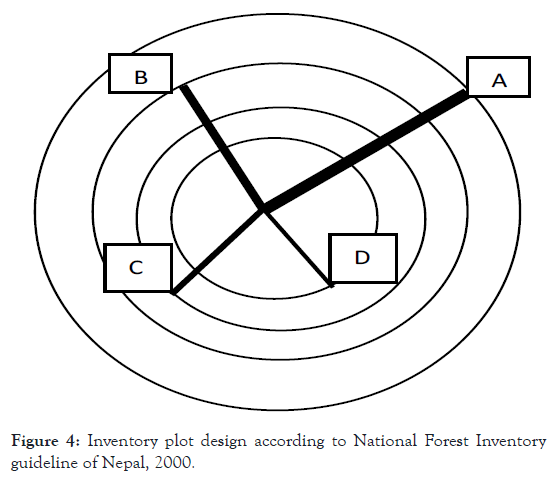
Figure 4. Inventory plot design according to National Forest Inventory guideline of Nepal, 2000.
| Symbol in Fig 4. | Radius (m) |
|---|---|
| A (For Tree) | 12.61 |
| B (For Poles) | 5.64 |
| C (For Saplings) | 2.82 |
| D (For Seedlings) | 1.78 |
Table 3: Description of research plot.
Data analysis
The ecological impact on the forest was measured in terms of species diversity, richness, evenness, stand density and the growing stock. Shannon-Weiner index was used to account for species composition (includes both abundance and evenness) and Margalef’s index was used to measure species richness. Similarly, Pielou index was used to measure evenness within species. Evenness value ranges from 0 to 1, where 1 means an equal distribution and values near 0 means unequal distribution.
Measurement of species diversity
The diversity employed here is α- diversity, which indicates the composition of species within a community. It was calculated by using Shannon-Weiner diversity index in 1963 [43].
 (1)
(1)
Where, Pi = Proportion of individual species in the community ‘i’.
Measurement of species richness
Margalef’s index was used to measure species richness [44].
Margalef’s index= (S –1)/ln N (2)
Where, S = Total number of species,
N= Total number of individuals in the sample.
Measurement of evenness
Pielou’s Evenness Index (e) was used to measure evenness of species/equitability [45].
Pielou’s Evenness Index (e) =H /ln S (3)
where, H =Shannon– Wiener diversity index,
S = Total number of species in the sample.
Measurement of species density and growing stock
For the calculation of species density at regeneration and sapling level, as well as stock density at tree and pole level, the following Equations- (5) and (6) were used:


Ecological impact of IAPS removal in the forest condition
By comparing the forest condition between the control and treatment blocks, the impact of removing IAPS was analysed. The forest condition was assessed in the following terms.
Species diversity
The value of Shannon-Weiner index is higher in treatment block in compare to the control block. The diversity index increased from 2.63 to 2.76 in Thanimai CF, 1.56 to 1.74 in Nawajagriti CF and 2.51 to 2.69 in Sagaswoti CF (Figure 5).
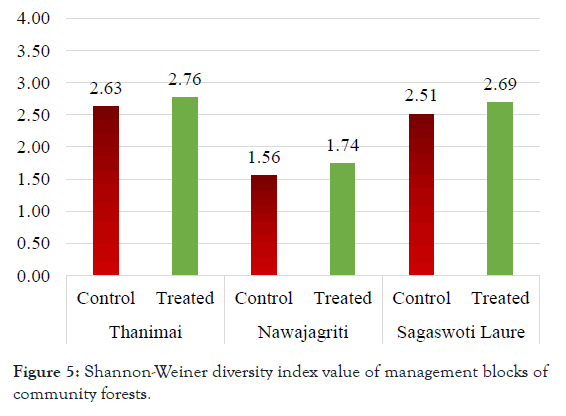
Figure 5. Shannon-Weiner diversity index value of management blocks of community forests.
Species richness
The higher value of Margalef’s index in the treatment block indicated the increase in species richness after the removal of IAPS in the forest. The species richness increased from 3.51 to 3.52 in Thanimai CF, 2.23 to 2.41 in Nawajagriti CF and 3.39 to 3.41 in Sagaswoti Laure CF (Figure 6). Furthermore, the number of regeneration species were also recorded to be higher in treatment block in compare to the control block. Control block of Thanimai, Nawajagriti and Sagaswoti Laure had 20, 15 and 21 species of regeneration, respectively. While looking at treatment block, 22, 17 and 22 species were encountered in Thanimai, Nawajagriti and Sagaswoti Laure CF respectively (Table 4).
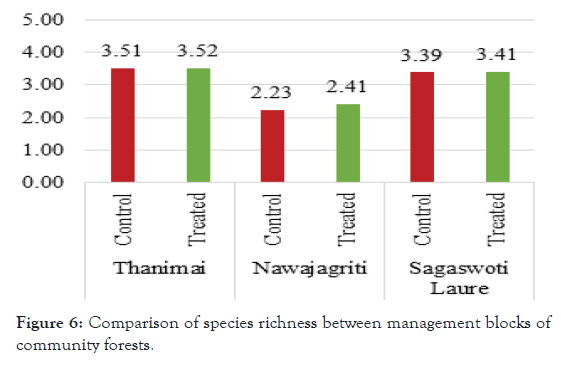
Figure 6. Comparison of species richness between management blocks of community forests.
| Name of CF | Block | No. of species |
|---|---|---|
| Thanimai | Control | 20 |
| Treatment applied | 22 | |
| Nawajagriti | Control | 15 |
| Treatment applied | 17 | |
| Sagaswoti Laure | Control | 21 |
| Treatment applied | 22 |
Table 4: No. of species of regeneration in different blocks of CF.
Species evenness
The Pielou’s evenness index showed the evenness in treated block is higher in comparison of the control block in all CF. This implies, the evenness is nearer to the optimal value that can be obtained in treatment applied block. The regeneration in treated block of Thanimai CF was found to be even by 0.01. Similarly, the evenness of regeneration of treated block of Nawajagriti CF and Sagaswoti CF were found to be more by 0.03 and 0.04, respectively (Figure 7).
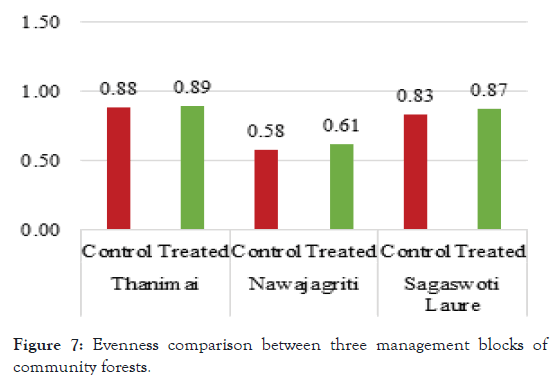
Figure 7. Evenness comparison between three management blocks of community forests.
Species density and growing stock
The seedling and sapling density per hectare were higher in the treatment block. But tree density was found to be higher in the control block than in treatment applied blocks (Figure 8). The growing stock is recorded higher in treatment applied block of all three CF (Table 5). The growing stock of treatment applied block and control block of Thanimai CF is 122.37 m3 and 103.87 m3 respectively. 196.7 m3 and 162.88 m3 is the recorded growing stock of treatment applied block and control block of Nawajagriti respectively. Similarly, Sagaswoti Laure CF had growing stock of only about 40 m3 in the treatment applied block while 32.76 m3 in control block.
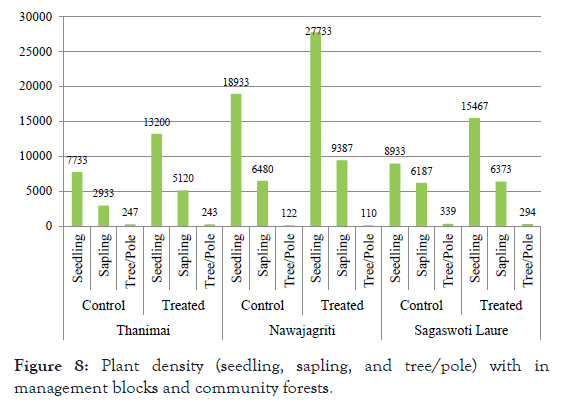
Figure 8. Plant density (seedling, sapling, and tree/pole) with in management blocks and community forests.
| Name of CF | Block | Growing stock by volume (m3) |
|---|---|---|
| Thanimai | Treatment applied | 122.37 |
| Control | 103.87 | |
| Nawajagriti | Treatment applied | 196.77 |
| Control | 162.88 | |
| Sagaswoti Laure | Treatment applied | 39.41 |
| Control | 32.76 |
Table 5: Growing stock at regeneration level.
The presence of invasive alien species poses a threat to the native species through the competition for space and other factors [46]. Most economical and effect way to manage invasive species is to prevent its introduction and detect early and take necessary steps to eradicate them before it causes noticeable damage [47,48]. The removal of invasive plant species is motivated by conservation benefits such as alleviates its impact and to enhance the recovery of native, endangered or endemic species and ecosystem processes as well [49-51]. In Nepal, community forests are removing IAPS to enhance the survival of native species and to minimize the effects on forest biodiversity. Removal of IAPS is carried out as the scheduled activities by maintaining provision in forest operation plan endorsed by CF to achieve the goal of sustainable management. The sustainable forest management involves the consideration of the ecological factors like forest condition and maintenance of diversity. In this study assessing impact on the ecology of forest is, therefore, important to ensure the ecological sustainability of forest. The impact was measured through the study of forest diversity and forest condition using the ITTO indicators and verifiers.
Our study found increment in species diversity after removal of IAPS in community forests. Moreover, the species richness seemed to increase after removing the IAPS from all three community forests. This result agrees with study conducted by Torras and Saura [52], who stated that the species richness is significantly higher in managed forests in compare to that in the unmanaged ones. Species diversity index was found higher in treated site than control site while assessing regeneration potential of plant species in lower region of Nepal [53], which also supports our findings. Among all CFs, the value of diversity index is lower in Nawajagriti CF, which represents the lower fertile region of Nepal i.e., Terai. This is because this forest is largely dominated by regeneration of Shorea robusta in comparison to other species. The area states low diversity if area is dominated by the specific plant community [54], which agree with the findings of this study. Removing IAPS can be considered as the moderate disturbance in terms of forest management. Similarly, our findings regarding species diversity and species richness are in consistent with findings of Biswas and Mallik [55], who mentioned that species richness and diversity reached peak at moderate disturbance intensity in the forest. It can be said the moderate disturbance on all three CF results in higher species richness in comparison with control block, which is contrary to another study carried out in disturbed forests that found less diversity [56,57]. Similarly, Wu et al., [58] also found that species evenness and diversity of plant species recovered and increased during the medium intensity management, but these parameters had not recovered and decreased under high intensity management in the hardwood forest of China, which is consistent with our findings. Silviculture treatments have large impact on the density and growth of the regeneration in the forest [59]. Similarly, the study by Oli and Subedi [60] and Awasthi et al., [61] reported the higher seedling and sapling density in the managed forest in comparison to unmanaged forest with no regeneration felling. This is similar to our study, where the numbers of seedling and sapling are higher in the treatment applied block while comparing with control block. However, we found the low seedling-sapling ratio (around 2.5:1) in treatment applied block in all CF. This might be due to the management intervention over time series and resources competition of native species enhanced due to the removal of unwanted species like IAPS. This result is consistent to the findings of Sony baral et al., [62] suggest that despite profound regeneration, most of the seedlings did not survive due to resource competition. Similarly, in contrast, species density at tree level was found to be higher in the control area as compared to the managed ones. The removal of IAPS has direct benefits to the seedling and sapling but does not have a substantial effect on the distribution of tree within the short period [22]. The higher tree density in control block is quite consistent with the results of Awasthi et al., [61] who found higher tree density in control are with 552 trees/ha as compared to the managed ones (block I with 66 trees/ha and block II with 133 trees/ha). Furthermore, the growing stock (by volume) was higher in treatment applied blocks than in control blocks in all three CFs. It might be due to maintenance of canopy cover or understorey vegetation of preferred/ valuable species in community forest of Nepal. Our findings are similar to the results Neupane et al., [22] who stated that the promotion of valuable species and other forest management practices by CF enrich the value of stumpage in IAS managed block.
Treatment applied block showed higher plant diversity than the control block. According to Margalef’s Index and Pielou’s Eveness index, species richness as well as species evenness was found higher in treatment block than that of control block. Similarly, seedling and sapling density per hectare was found higher in the treatment block, whereas higher tree density in the control block. Furthermore, the growing stock (by volume) is found higher in treatment applied blocks in all three CFs. It can be said that management of IAPS through charcoal production could contribute to higher diversity at regeneration level, change in forest structure and increase the stumpage value too. Treatment showed positive response in terms of forest management but management implications of IAPS in community forest is rarely studied in Nepal. More studies regarding charcoal approach illustrating it’s ecological and economic benefit to forest as well as users should be carried out. For scaling-up and replicating this approach, the approach of IAPS removal for economic benefit should be mainstreamed in all forest related policy and all phases of forest development management cycles. IAPS should be identified as non-timber products and their collection and conversion to charcoal should incorporated in existing laws. Similarly, more community forest user groups, local people and organization related to this sector should be encouraged for management and utilization of IAPS for biological and economic benefit.
Conceptualization, writing-original draft, K.P.B, A.A; Methodology, K.P.B, M.P.N.; Data collection: S.K. and M.P.N.; Formal analysis and writing-A.A.
The authors highly acknowledge Bioenergy for providing financial support to carry out this research. We equally appreciate the role of Suman Ghimire for his sincere support to complete this research.
The authors declare no conflict of interest.
Citation: Bhatta KP, Neupane MP, Aryal A, Khanal S (2021) Impact of Invasive Alien Plant Species Removal in the Forest Management: Findings from Terai and Mid-Hills of Nepal. J Forest Res. 10:254.
Received: 27-Feb-2021 Accepted: 17-Mar-2021 Published: 24-Mar-2021 , DOI: 10.35248/2168-9776.21.10.254
Copyright: © 2021 Bhatta KP, et al. This is an open-access article distributed under the terms of the Creative Commons Attribution License, which permits unrestricted use, distribution, and reproduction in any medium, provided the original author and source are credited.